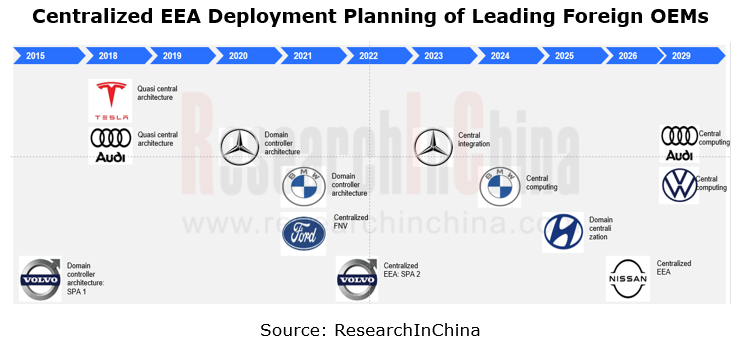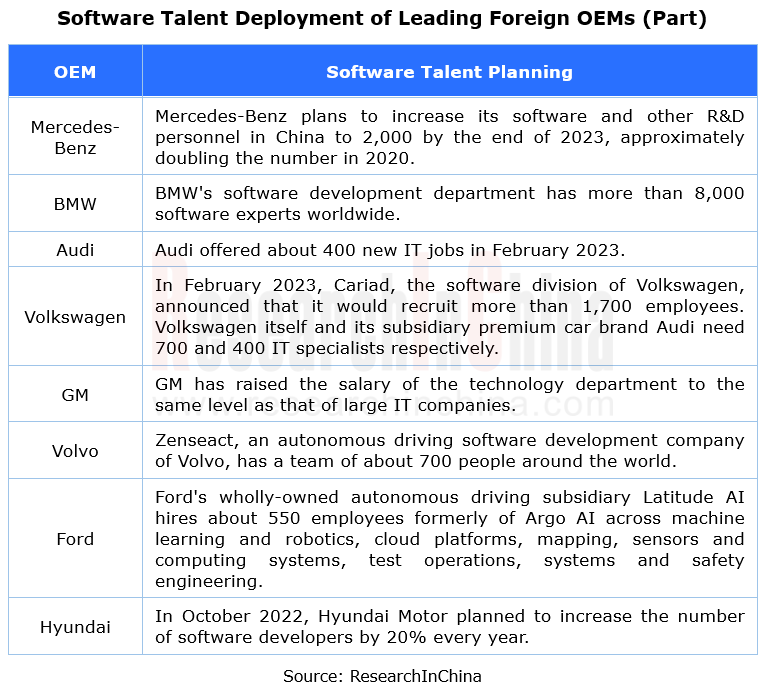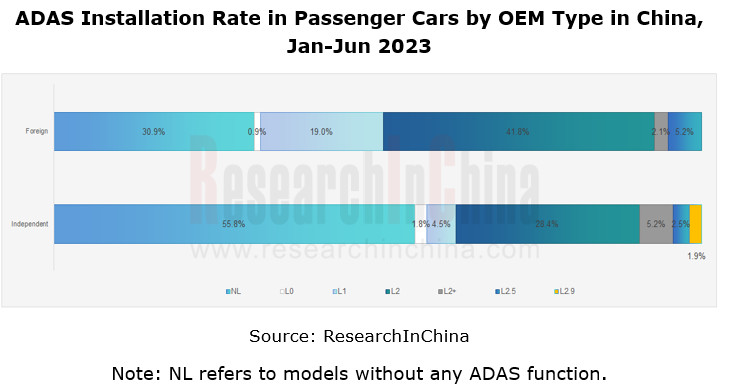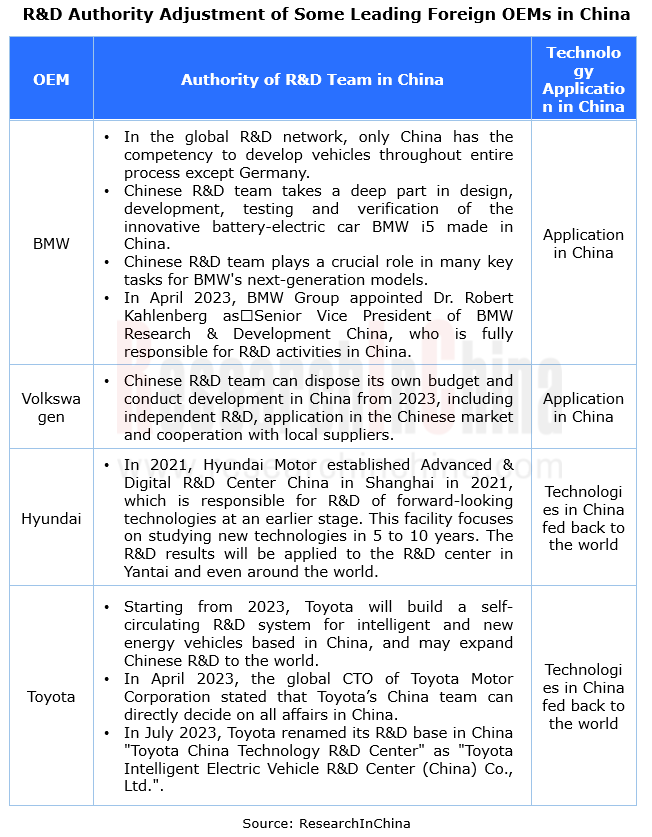Global automakers evolve to software-defined vehicles by upgrading EEAs.
Centralized electronic/electrical architectures (EEA) act as the hardware foundation to realize software-defined vehicles. At present, leading foreign OEMs are aggressively deploying centralized EEA.
For example, Mercedes-Benz's newly developed electronic architecture uses a central processor (254TOPS) to replace the previous independent computing controllers, making data calculation and transmission faster and more stable. It will be installed in Mercedes-Benz E-Class, a model expected to be marketed in China in November 2023.
Hyundai Motor is developing domain centralized EEA to manage ever more electrical components by system efficiency. The domain centralized architecture divides main vehicle functions into four domains: comfort, driving, infotainment and ADAS, so as to ensure vehicles improve efficiency via OTA updates. Hyundai Motor Group plans to apply the domain centralized architecture to all its models worldwide by 2025.
Renault-Nissan-Mitsubishi Alliance is also developing a common centralized electronic and electrical architecture converging electronics hardware and software applications. By 2026, the next generation of models under the alliance will use this architecture. The alliance will also launch its first software-defined vehicle by 2025 to improve the full life cycle OTA performance of vehicles.

Leading foreign OEMs build core software capabilities by strengthening their software talent deployment.
For the transition to software-defined vehicles, leading foreign OEMs have increased their investment in software and algorithm talents. In February 2023, Cariad, the software division of Volkswagen, announced that it would recruit more than 1,700 employees. Volkswagen itself and its subsidiary premium car brand Audi need 700 and 400 IT specialists respectively. In May 2023, Toyota announced that it would train 9,000 employees in-house by 2025, hoping to turn them into software developers. In May 2023, Nissan strengthened cooperation with KPIT Technologies, an Indian R&D company. Based on this partnership, KPIT Technologies plans to increase the number of its vehicle system software development experts working for Honda from 1,100 to a level close to 2,000 by 2030.

At the same time, leading foreign OEMs are exploring AI technology, especially the application of generative AI in autonomous driving and cockpits, for movement towards intelligence.
In September 2023, Amazon Web Services (‘’AWS’’) announced the BMW Group had chosen AWS as the preferred cloud provider for its automated driving platform. The BMW Group will develop its next-generation advanced driver assistance system (ADAS) using AWS to help innovate new features for its next generation of vehicles, the “Neue Klasse,” set to launch in 2025. The new cloud-based system will leverage BMW's pre-existing Cloud Data Hub on AWS, and will use AWS compute, generative artificial intelligence (generative AI), Internet of Things (IoT), machine learning, and storage capabilities to help accelerate the delivery of highly automated BMW vehicles.
Tesla is also exploring the application of generative AI technology. In April 2023, Tesla registered a new artificial intelligence startup named X.AI Corp, in Nevada. The company plans to launch a generative AI platform called "TruthGPT", an alternative to ChatGPT.
In the product development stage, generative AI can automatically generate new designs through existing planned training models, so that designers can improve these designs, thereby reducing labor costs and improving efficiency. In June 2023, Toyota Research Institute (TRI) unveiled a generative AI technique to help employees design car shapes faster. A designer can request, via text prompt, a suite of designs based on an initial prototype sketch with specific stylistic properties like “sleek,” “SUV-like,” and “modern”.
Leading foreign OEMs will deploy ADAS functions in China.
From January to June 2023, 9.256 million passenger cars were sold in China, of which 4.713 million units (down 3.5% from the same period last year), or 50.9% of the total (down 4.1 percentage points on a like-on-like basis), came from foreign brands. During the same period, 3.258 million foreign brand passenger cars in China were equipped with ADAS, jumping by 12.9% from the prior-year period and accounting for 61.8% of China's overall ADAS installations (down 5.4 percentage points compared with the same period of the previous year); the ADAS installation rate rose by 10 percentage points to 69.1%.
In terms of ADAS level, from January to June 2023, 1.972 million foreign brand vehicles were fitted with L2 ADAS, with the installation rate up to 41.8%; 246,000 foreign brand vehicles were installed with L2.5 ADAS, with the installation rate up to 5.2%.

Leading foreign OEMs have made deployments for providing advanced intelligent driving assistance functions in the future.
In 2023H2, Mercedes-Benz will first launch its DRIVE Pilot feature in China. By then, Mercedes-Benz cars equipped with this function can drive from point to point on highways and urban expressways across the country.
Starting from 2024, SAIC-GM will provide the Chinese market with NOA and HPA on highways and urban public roads.
Tesla is also vigorously deploying its autonomous driving business in China, hoping to introduce its FSD solution in China (expected in 2024). In August 2023, Tesla planned to establish a local operation team of around 20 people to implement its FSD solution into the Chinese market. Tesla also tried to set up a data labeling team consisting of about 100 people in China to prepare for training the FSD algorithm.
Leading foreign OEMs are open to cooperation in China and shore up their weak spots.
Faced with the rising passenger car sales of Chinese local OEMs and intelligence competition from them, leading foreign OEMs have become more open in layout and cooperation in China, decentralizing power to their R&D teams in China and exchanging capital for technology to shore up their weak spots.
First, leading foreign OEMs, including BMW, Volkswagen and Hyundai Motor, have given their R&D teams in China more authority. In addition, Toyota and Nissan have put forward the idea of feeding back technologies in China to the world.

Second, since the second half of 2023 many leading foreign OEMs have begun to quicken their pace of mass-producing intelligent driving to gain greater competitive edges by cooperating with Chinese brands.
In July 2023, Volkswagen acquired a 4.99% stake in Xpeng for USD700 million. In terms of R&D, Xpeng will provide technologies such as vehicle platforms, intelligent cockpits and intelligent driving software, while Volkswagen is mainly responsible for the interior and exterior design of bodies and models.
In August 2023, Nissan intended to cooperate with Dongfeng Motor, and use the S BEV platform in Dongfeng Motor's “Quantum Intelligent Electric Architecture” (launched in April 2023) for R&D and production. The new quantum architecture will be equipped with 800V high-voltage fast charging technology, enabling a cruising range of more than 1,200 kilometers, and supporting shared battery swapping.
In September 2023, Hyundai Motor Group announced that it would strengthen cooperation with BAIC Group in new energy vehicles, and the models in their cooperative project were in the development and testing stage.
According to LatePost Auto, Huang Chang, CTO of Horizon Robotics, will join the joint venture between Horizon Robotics and Volkswagen with some senior R&D personnel from Horizon Robotics. The joint venture will use the intelligent driving solutions and algorithm training platform of Horizon Robotics to provide Volkswagen with driving assistance functions including highway NOA.
With the help of local ADAS suppliers in China, leading foreign OEMs will narrow the gap with Chinese local OEMs in intelligent driving functions in the next 2 or 3 years.
Automotive Digital Power Supply and Chip Industry Report, 2024
Research on automotive digital power supply: looking at the digital evolution of automotive power supply from the power supply side, power distribution side, and power consumption side
This report fo...
Automotive Software Business Models and Suppliers’ Layout Research Report, 2024
Software business model research: from "custom development" to "IP/platformization", software enters the cost reduction cycle
According to the vehicle software system architecture, this report classi...
Passenger Car Intelligent Steering Industry Research Report, 2024
Intelligent Steering Research: Steer-by-wire is expected to land on independent brand models in 2025
The Passenger Car Intelligent Steering Industry Research Report, 2024 released by ResearchInChina ...
China Passenger Car Mobile Phone Wireless Charging Research Report, 2024
China Passenger Car Mobile Phone Wireless Charging Research Report, 2024 highlights the following:Passenger car wireless charging (principle, standards, and Qi2.0 protocol);Passenger car mobile phone ...
Automotive Smart Exteriors Research Report, 2024
Research on automotive smart exteriors: in the trend towards electrification and intelligence, which exteriors will be replaced by intelligence?
The Automotive Smart Exteriors Research Report, 2024 ...
Automotive Fragrance and Air Conditioning System Research Report, 2024
Research on automotive fragrance/air purification: With surging installations, automotive olfactory interaction is being linked with more scenarios.
As users require higher quality of personalized, i...
Intelligent Vehicle Multi-Domain Computing Industry Report, 2024
Multi-Domain Computing Research: A Summary of Several Ideas and Product Strategies for Cross-Domain Integration
1. Several ideas and strategies for cross-domain integration of OEMs
With the increasi...
Analysis on Xiaomi Auto's Electrification, Connectivity, Intelligence and Sharing, 2024
Research on Xiaomi Auto: Xiaomi Auto's strengths and weaknesses
Since the release of SU7, Xiaomi delivered 7,058 units and 8,630 units in April and May, respectively, and more than 10,000 units in bo...
ADAS and Autonomous Driving Tier 1 Suppliers Research Report, 2024 - Foreign Companies
Research on foreign ADAS Tier 1 suppliers: make all-round attempts to transform and localize supply chain and teams.
1. Foreign ADAS Tier 1 suppliers fall behind relatively in deve...
Research Report on Passenger Car Cockpit Entertainment--In-vehicle Game, 2024
1. In-vehicle entertainment screens are gaining momentum, and Chinese brands rule the roost.
In-vehicle entertainment screens refers to display screens used for entertainment activities such as viewi...
Body (Zone) Domain Controller and Chip Industry Research Report,2024
Research on body (zone) domain controller: an edge tool to reduce vehicle costs, and enable hardware integration + software SOA.
Integration is the most important means to lower vehicle costs. Funct...
China Charging/Swapping (Liquid Cooling Overcharging System, Small Power, Swapping, V2G, etc) Research Report, 2024
Research on charging and swapping: OEMs quicken their pace of entering liquid cooling overcharging, V2G, and virtual power plants.
China leads the world in technological innovation breakthroughs in ...
Autonomous Driving SoC Research Report, 2024
Autonomous driving SoC research: for passenger cars in the price range of RMB100,000-200,000, a range of 50-100T high-compute SoCs will be mass-produced. According to ResearchInChina’s sta...
Automotive Cockpit Domain Controller Research Report, 2024
Research on cockpit domain controller: Facing x86 AI PC, multi-domain computing, and domestic substitution, how can cockpit domain control differentiate and compete?
X86 architecture VS ARM ar...
Chinese OEMs (Passenger Car) Going Overseas Report, 2024--Germany
Keywords of Chinese OEMs going to Germany: electric vehicles, cost performance, intelligence, ecological construction, localization
The European Union's temporary tariffs on electric vehicles in Chi...
Analysis on DJI Automotive’s Autonomous Driving Business, 2024
Research on DJI Automotive: lead the NOA market by virtue of unique technology route.
In 2016, DJI Automotive’s internal technicians installed a set of stereo sensors + vision fusion positioning syst...
BYD’s Layout in Electrification, Connectivity, Intelligence and Sharing and Strategy Analysis Report, 2023-2024
Insight: BYD deploys vehicle-mounted drones, and the autonomous driving charging robot market is expected to boom.
BYD and Dongfeng M-Hero make cross-border layout of drones.
In recent years,...
Great Wall Motor’s Layout in Electrification, Connectivity, Intelligence and Sharing and Strategy Analysis Report, 2023-2024
Great Wall Motor (GWM) benchmarks IT giants and accelerates “Process and Digital Transformation”.
In 2022, Great Wall Motor (GWM) hoped to use Haval H6's huge user base to achieve new energy transfo...